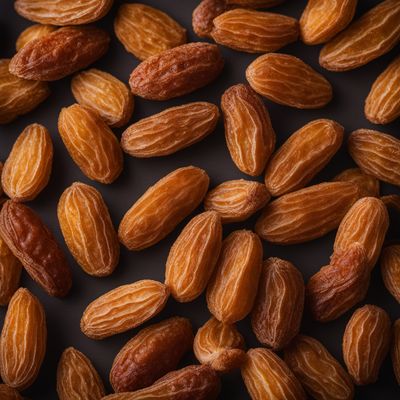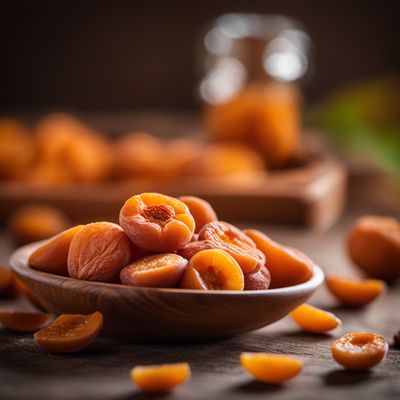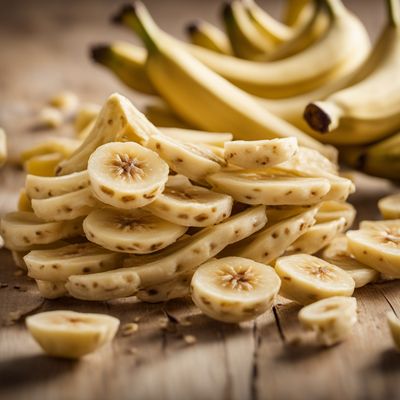
Ingredient
Dried pears
The Sweet Essence of Preserved Pears
Dried pears are made by removing the moisture from fresh pears, resulting in a chewy and intensely flavored fruit. They have a golden-brown color and a slightly wrinkled appearance. The texture is tender yet firm, and the taste is sweet with subtle hints of the original pear's flavor. These dried fruits are a great source of natural sugars and dietary fiber, making them a healthy and delicious addition to your diet.
Origins and history
Dried pears have been enjoyed for centuries, with evidence of their consumption dating back to ancient Rome and China. The drying process was a popular method of preserving fruits before the advent of refrigeration. Today, dried pears are produced worldwide, with notable cultivation in China, the United States, and Europe. They are often associated with holiday baking and are a common ingredient in traditional fruitcakes and desserts.
Nutritional information
Dried pears are a good source of dietary fiber, providing approximately 20% of the recommended daily intake per serving. They also contain essential vitamins and minerals, including vitamin C, potassium, and copper. Additionally, dried pears are relatively low in calories, with around 100 calories per ounce.
Allergens
Dried pears may contain sulfites, which can cause allergic reactions in some individuals, particularly those with asthma or sulfite sensitivity. It is important to check the packaging for any potential allergen warnings before consuming.
How to select
When selecting dried pears, look for ones that are plump, slightly soft, and free from any signs of mold or discoloration. They should have a vibrant golden-brown color and a pleasant aroma. Avoid any packages that have excessive moisture or clumping, as this may indicate poor quality or improper storage.
Storage recommendations
To maintain the freshness and quality of dried pears, store them in a cool, dry place in an airtight container. Avoid exposure to moisture, heat, or direct sunlight, as these can cause the fruit to spoil or lose its flavor. Properly stored dried pears can retain their quality for up to a year.
How to produce
Dried pears can be produced at home by slicing fresh pears and dehydrating them using an oven or food dehydrator. Simply arrange the pear slices on a baking sheet or dehydrator tray and dry them at a low temperature until they become leathery and dry to the touch. Homemade dried pears can be stored in airtight containers for several months.
Preparation tips
Dried pears can be enjoyed as a healthy snack on their own or incorporated into a variety of dishes. They add a delightful sweetness to baked goods such as cakes, muffins, and cookies. They can also be used in salads, trail mixes, granola bars, and savory dishes like stews or tagines for a touch of natural sweetness. Additionally, dried pears can be rehydrated and used in compotes, jams, or chutneys.
Culinary uses
Dried pears are commonly used in baking, particularly in fruitcakes, bread, and pastries. They are also popular in trail mixes, granola bars, and salads. In savory dishes, dried pears can be added to stews, tagines, or stuffing for a unique flavor twist. They are a versatile ingredient that can enhance both sweet and savory recipes.
Availability
Dried pears are widely available in grocery stores, supermarkets, and specialty food stores. They can also be purchased online from various retailers.
More ingredients from this category

Dried dates
Nature's Sweet Gems

Dried figs
Nature's Sweet Gems: Dried Figs

Dried apricots
The Golden Gems: Unveiling the Delights of Dried Apricots

Dried bananas
Nature's Sweet and Chewy Delight: Dried Bananas

Chocolate coated dried fruit
Decadent Delights: Chocolate Coated Dried Fruit

Fruit chips
Crispy Delights: Fruit Chips

Dried vine fruits (raisins etc.)
Nature's Sweet Gems

Mixed dried fruits
Nature's Sweet Medley: Exploring the World of Mixed Dried Fruits

Dried prunes
Nature's Sweet and Tangy Gems

Dried mangoes
The Sweet and Tangy Delight

Dried apples
The Sweet Essence of Sun-Dried Apples

